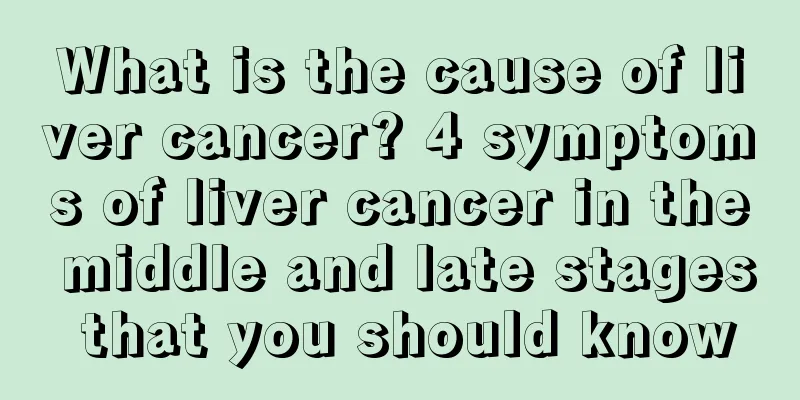What is the cause of liver cancer? 4 symptoms of liver cancer in the middle and late stages that you should know

|
Causes of Liver Cancer 1. About 1/3 of liver cancer patients have a history of chronic hepatitis, and the positive rate of Australia antibody (HbsAg) is significantly higher than that in low-incidence areas. It has been found that hepatitis C virus infection, like hepatitis B infection, is closely related to the incidence of liver cancer. Hepatitis B virus and hepatitis C virus are definitely one of the cancer-promoting factors. 2. About 50% to 90% of liver cancer patients have concurrent cirrhosis. In recent years, it has been found that the proportion of hepatitis C developing into cirrhosis is no less than that of hepatitis B. 3. Experiments have shown that aflatoxin B1, a metabolite of aflatoxin, has a strong carcinogenic effect and exists in moldy corn, peanuts and other foods. In areas where food is seriously contaminated by aflatoxin B1, the incidence of liver cancer is also high. Nitrosamines, azo mustards, alcohol, organochlorine pesticides, etc. are all suspected carcinogens. 4. Some drinking water is often polluted by polychlorinated biphenyls, chloroform, etc. In recent years, it has been found that blue-green algae growing in ponds are strong carcinogenic plants that can pollute water sources. Parasitic diseases such as Clonorchis sinensis infection can stimulate bile duct epithelial hyperplasia and lead to primary bile duct cancer. 5. Long-term alcohol abuse is the number one killer of liver damage. This is because after alcohol enters the human body, it is mainly decomposed and metabolized in the liver. The toxicity of alcohol to liver cells causes liver cells to have obstacles in the decomposition and metabolism of fatty acids, causing fat deposition in the liver and resulting in fatty liver. Symptoms of liver cancer in the middle and late stages 1. Pain in the liver area. The most common type is intermittent or persistent dull pain or bloating. The rapid growth of the tumor will tighten the liver capsule and invade the diaphragm, causing pain. This pain can radiate to the right shoulder or right back. A tumor growing to the right back can cause right waist pain. Sudden onset of severe abdominal pain and peritoneal irritation signs indicates subcapsular bleeding of the cancerous nodule or rupture into the abdominal cavity. 2. Gastrointestinal symptoms, such as loss of appetite, indigestion, nausea, vomiting and diarrhea, are easily overlooked due to their lack of specificity. 3. Fatigue, weight loss, general weakness, and a few patients in the late stage may develop cachexia. 4. Fever, generally low-grade, occasionally reaching above 39°C, presenting as persistent fever, low-grade fever in the afternoon, or high fever of the remittent type. Fever is related to the absorption of necrotic products of the tumor. Compression or invasion of the bile duct by the tumor may lead to biliary infection. |
Recommend
How to prevent pancreatic cancer
Although the exact cause of pancreatic cancer is ...
How to remove fishy smell at home
Fish will inevitably have a fishy smell, but this...
Symptoms of damp-heat obstruction
Dampness and heat is a common phenomenon in moder...
Physical therapy for chest tightness and shortness of breath
Some people may suddenly feel their chest is very...
What is the reason for back pain and arm pain
Humans use their arms when carrying out their nor...
When is the best time to use eye drops?
Drink water when you are thirsty, rest when you a...
Do decayed deciduous teeth need to be filled?
We have all experienced the period of tooth repla...
What are the main examination methods for lung cancer? A complete list of examination methods for diagnosing lung cancer
Some patients with lung cancer neglect to pay att...
Is it okay to drink yogurt after eating an apple? How to make apple yogurt
Apples are rich in nutrients, especially minerals...
What to do if pancreatic cancer causes ascites
From the beginning of the disease, adverse sympto...
Is there any hope for recurrence of colon cancer after surgery?
Colorectal cancer is a common clinical malignant ...
What is non-keratinizing nasopharyngeal carcinoma
In China, nasopharyngeal carcinoma is a very comm...
You can't move your head when you sleep to be awake
When you sleep, your brain is awake, but your bod...
Let’s learn about the symptoms of kidney cancer
Kidney cancer is a common cancer in life. So what...
Why do I have diarrhea every few days?
Poor gastrointestinal condition has become a dise...









